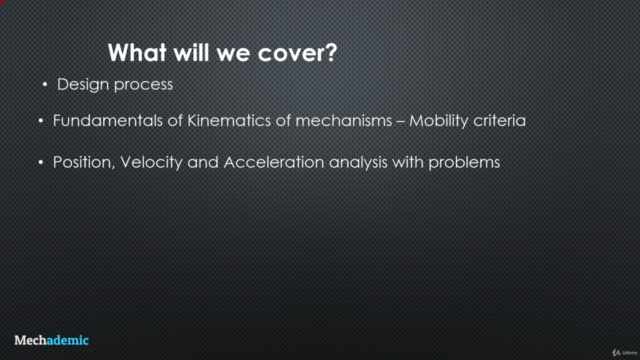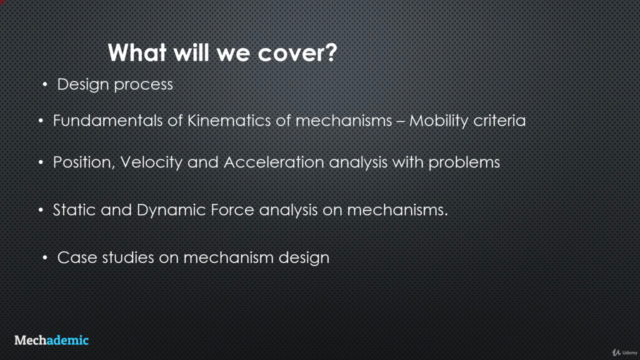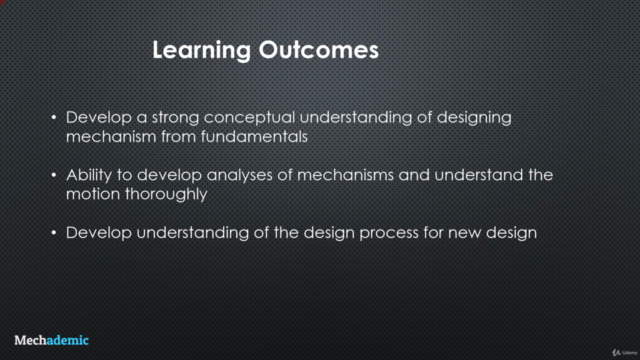Basics of Kinematic analysis in Mechanism design

Why take this course?
🎓 Mastering Kinematic Analysis in Mechanism Design: A Comprehensive Course for Engineers
🚀 Course Headline: Learn about how to design and analyze simple planar mechanisms with case studies for mechanical design engineers. This course is your gateway to mastering the fundamentals of kinematic analysis, essential for any engineer aiming to excel in mechanism design.
📚 Course Description: Mechanisms and structures are the building blocks of any successful mechanical design. In this engaging and comprehensive course, we will delve into the depths of the mechanics behind these systems. Our journey will take us through an in-depth exploration of the fundamentals of kinematic analysis as it applies to actual product or system design.
What You Will Learn:
- Overview of Mechanical Design Process: Discover where mechanism design fits within the larger context of mechanical engineering and understand the importance of a well-structured design process.
- Functional Requirements in Design: Grasp the significance of functional keywords in defining product requirements.
- Designing Mechanisms from Scratch: Learn the steps to approach designing mechanisms creatively and effectively.
- Analysis vs. Synthesis: Distinguish between analyzing existing systems and synthesizing new designs, and understand where each plays a crucial role.
- Degrees of Freedom: Understand the concept and its implications in mechanism design.
- Kinematic Pairs and Joints: Familiarize yourself with the various types of kinematic pairs and joints used in mechanisms.
- Planar vs. Spatial Mechanisms: Get an introduction to both planar and spatial mechanisms and learn how they differ.
- Mobility and Kutzbach Criteria: Apply the Kutzbach criteria to determine the mobility of planar mechanisms and understand the principles behind it.
- Spatial Mechanism Criteria and Examples: Analyze spatial mechanisms with real-world examples.
- Kinematic Inversions: Learn how to perform kinematic inversion to gain insights into mechanism design.
- Grashof Criteria for 4-Link Mechanisms: Dive into the Grashof criteria and its significance in analyzing four-bar linkage mechanisms.
- Basics of Position Vectors and Loop Closure Equations: Gain proficiency in position vectors and solving loop closure problems.
- Finding Position of a Point on a Link: Learn techniques to determine the position of any point on the links within a mechanism.
- Velocity Analysis Fundamentals: Understand the basics of velocity analysis and its application in both four-link mechanisms and slider crank mechanisms.
- Acceleration Analysis Introduction: Get an overview of acceleration analysis and the challenges involved.
- Static Force Analysis: Learn about static force analysis, which is fundamental to understanding the forces at play within a mechanism.
- Dynamic Force Analysis: Explore dynamic force analysis, including concepts of inertia and D'Alembert's principle.
- Problem Solving in Dynamic Force Analysis: Tackle common problems encountered during dynamic force analysis.
- Case Studies: Apply your knowledge to real-world scenarios, where you'll see how mechanism design principles are applied to actual product or system designs.
Course Outcomes: This course aims to:
- Conceptual Understanding: Develop a strong conceptual understanding of designing mechanisms from fundamentals.
- Analytical Skills: Ability to develop analyses of mechanisms and understand the motion thoroughly.
- Design Process Mastery: Enhance your ability to approach the design process for new designs with confidence.
Who Should Take This Course? This course is perfect for:
- Mechanical Design Engineers
- Aspiring Mechanism Designers
- Engineering Students looking to specialize in Mechanisms and Systems
- Any professional who wants to solidify their understanding of the basics of kinematic analysis.
Join us on this enlightening journey through the world of mechanisms, where you'll gain the skills necessary to design and analyze simple planar mechanisms, tackle real-world engineering problems, and take your mechanical design expertise to new heights. 🚀🛠️
Course Gallery




Loading charts...